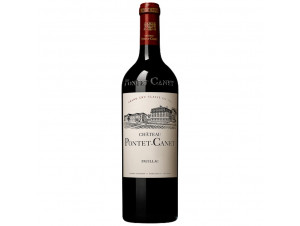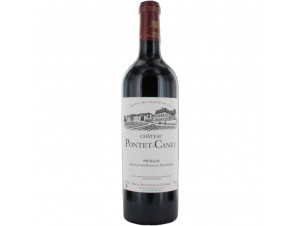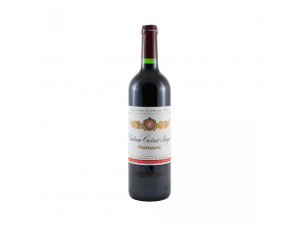You have no items in your shopping cart.
Wine Pauillac
The port town of Pauillac, which gives its name to the appellation, has 18 grands crus classés and three premiers grands crus among the five premiers grands crus classés in 1855. Its location allowed the wine trade to flourish from the 17th century onwards. Indeed, the exceptional character of the region's wines quickly contributed to their reputation. Read more on Pauillac
-
Top Selling-32%
-
Top Selling
-
Top Selling
- -34%
Appellation Pauillac
Stendhal already praised the terroir of Pauillac
The vine growing began to develop in Pauillac in the 14th and 15th centuries, but it was in the 18th century that it really took off. During the industrial revolution, and thanks to its location on the banks of the Gironde River, Pauillac was the departure point for transatlantic liners bound for the Americas. Notably, in 1777, the Marquis de La Fayette set sail from Pauillac to rescue the American people during the War of Independence.
As in the whole of Bordeaux, the prosperity of the vineyards of Pauillac was halted in its momentum by the phylloxera crisis in 1879 and that caused by mildew in 1882. It took nearly a century to recover, and it was from the 1950s and 1960s that it finally experienced a real renaissance.
The appearance of the city and its quays still reflects the golden age of the 18th and 19th centuries. Stendhal, impressed by its beauty, described it as follows: "Suddenly we see, on the left side of the river, eight to ten beautiful three-story houses that look like opulent country houses: this is Pauillac. This is Pauillac." The 18 Grands Crus Classés appellation was validated by the decree of November 14, 1936, which defined its specifications.
In fact, 18 Pauillac chateaux were included in the 1855 classification of the grands crus classés, among which three were elected premiers grands crus classés, the Châteaux Lafite-Rothschild, Latour and Mouton-Rothschild.
The Pauillac appellation counts 18 crus classés
The AOC Pauillac, located on the left bank of the Gironde, and exposed to exceptional climatic and geological conditions, produces very great wines. The appellation area includes 1.200 hectares of vines and produces every year 54.000 hectolitres of red wine. Note that Mouton-Rothschild also produces a white wine.
The crus classés represent 85% of the production of the appellation. Located on a gravelly hilltop, its vineyards are planted with Cabernet Sauvignon associated with Merlot and, to a lesser extent, Petit Verdot and Malbec. The Pauillac appellation area extends on the left bank of the Gironde estuary, on a strip of land seven kilometers long and four kilometers wide. It is bounded to the north by the Jalle du Breuil and to the south by the Juillac stream. In the commune of Pauillac, it also includes a few plots of land located in the communes of Cissac-Médoc, Saint-Estèphe, Saint-Julien-Beychevelle and Saint-Sauveur, as defined by the appellation's specifications.
The vineyard is located on quaternary gravelly terraces, covered with graves garonnaises and distributed in crests with variable gradients, between 3 and 30 meters. Notably, the Château Lafite-Rothschild culminates at an altitude of 30 meters above the Jalle du Breuil and the Lafite marsh, and the Château Mouton-Rothschild also sits at 30 meters. The hilltops have optimal drainage and the water flows naturally towards the marshes and streams at the bottom of the slopes, which carry them towards the Gironde.
Château Latour, on the other hand, rests on a subsoil that is more clayey than limestone. And its gravels are of a remarkable quality. Dating from the Quaternary, they accumulate the heat of the sun during the day, which they restore during the night, thus playing the role of thermal regulator. They are very favorable to the grape varieties of cabernet franc and cabernet-sauvignon. Merlot, on the other hand, flourishes on clayey soils. The grape variety is about 70 to 80% Cabernet Sauvignon and to a lesser extent Cabernet Franc, Carmenère, Merlot, Malbec and Petit Verdot.
Pauillac wines have an exceptional ageing potential
The robe of Pauillac red wines is very characteristic of Bordeaux, as it offers a ruby color with purplish tints.
The mouth is ample and supple and the attack is very powerful. The tanins are fine, but firm and full-bodied. The nose is complex, notes of red and black fruits, morello cherries and blackcurrant, gradually giving way to aromas of vanilla, leather, and finally to spices, liquorice, oak and toasted new wood. The final note is very long.
After a few years, the tannins open up, and losing their initial aggressiveness, they melt into the matter.
The ageing potential of these wines is absolutely exceptional, especially for great years. They go wonderfully with truffle and foie gras dishes, but also with game, red meat and cheese. They are intended to be consumed with typical and refined dishes. They should be decanted two hours before serving.
There were no less than six great vintages during this period: 2001, 2002, 2004, 2006, 2008, 2010 and a very great vintage in 2003. The years 2000 and 2009 are recognized as exceptional vintages. And finally, the ultimate recognition, the year 2005 is crowned vintage of the century.
Discovering 3 prestigious châteaux classified as "premiers grands crus" within the AOC Pauillac
Château Lafite-Rothschild
The château Lafite Rothschild extends over 178 hectares, including 103 hectares of vines. Located in the commune of Pauillac, it produces wine under the appellation of the same name. The wine was already known and appreciated in London at the beginning of the 18th century, but also at the court of King Louis XV and Richelieu. The wine was already known and appreciated in London at the beginning of the 18th century, but also at the court of King Louis XV and Richelieu. It is the daughter of Baron Eric, Saskia de Rothschild, aged 30, who has been at the head of the Barons de Rothschild estates since 2018.She represents the 6th generation of Rothschilds at the head of the wineries, and this with great success, as she accumulates great vintages, especially 2009 which was a great year for this exceptional wine.
Château Latour
The oldest document mentioning Latour dates back to 1331, it is a permit to build a fortified tower in the parish of Saint-Maubert. Château Latour is then mentioned in the Chronicles of Jean Froissart in 1378. The "Tour de Saint-Maubert" is a stronghold guarding the estuary for the King of France at the heart of the Hundred Years' War. At the end of the 17th century, the property passed into the hands of Alexandre de Ségur. The legendary "Prince of the Vines", his son Nicolas-Alexandre, so named by Louis XV, took over the property in 1716. The estate has never ceased to be prosperous over the centuries.In 1989, Allied Lyons held 93% of the shares, with the remaining 7% remaining to the heirs of the de Ségur family. In June 1993, François Pinault bought out the shares of Allied Lyons. The estate was completely renovated in 1999. Château Latour, a 78-hectare vineyard along the Gironde estuary, is planted with 80% Cabernet Sauvignon, 18% Merlot and 2% Cabernet Franc and Petit Verdot. We owe it the exceptional vintage Château Latour of 2005.
Château Mouton Rothschild
Estate belonging to the "Prince of the vines", the Marquis Nicolas-Alexandre de Ségur, in the 18th century, with Lafite and Latour, then to the Barons de Brane who named it Brane-Mouton, Château Mouton Rothschild was renamed after its acquisition in 1853 by Baron Nathaniel de Rothschild. In 1922, the young Baron Philippe de Rothschild, his great-grandson, who was 20 years old at the time, decided to take over the estate to devote his whole life to it. When he died in 1988, his daughter, the actress Philippine de Rothschild, took over the reins of the estate.It is on her initiative that important works are implemented in 2011 to rebuild the cellars. Philippe Dhalluin is in charge of the general management of the vineyard and is supported by the famous oenologists of the Médoc, Jacques and Eric Boissenot. At present, Philippine de Rothschild's three children, Camille Sereys de Rothschild, Philippe Sereys de Rothschild and Julien de Beaumarchais de Rothschild, manage the estate, and we owe them many vintages, such as the Mouton-Rothschild of 2009, rated 99/100 by Robert Parker.
Bordeaux appellations
Côtes-de-Bordeaux-Saint-Macaire








































 TWIL - Achat de Vin
TWIL - Achat de Vin


